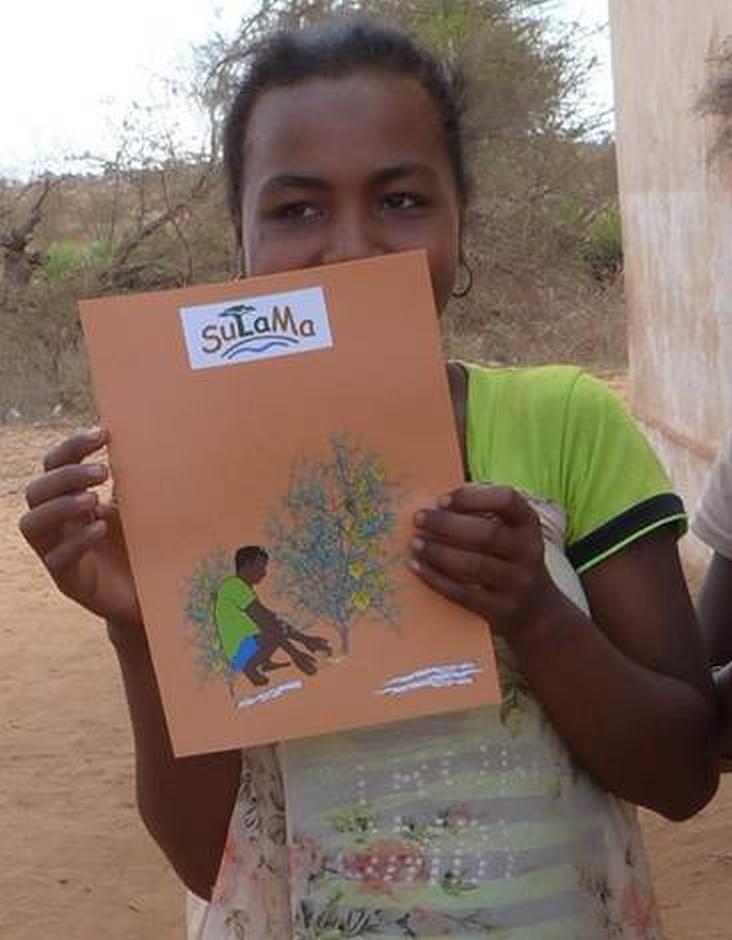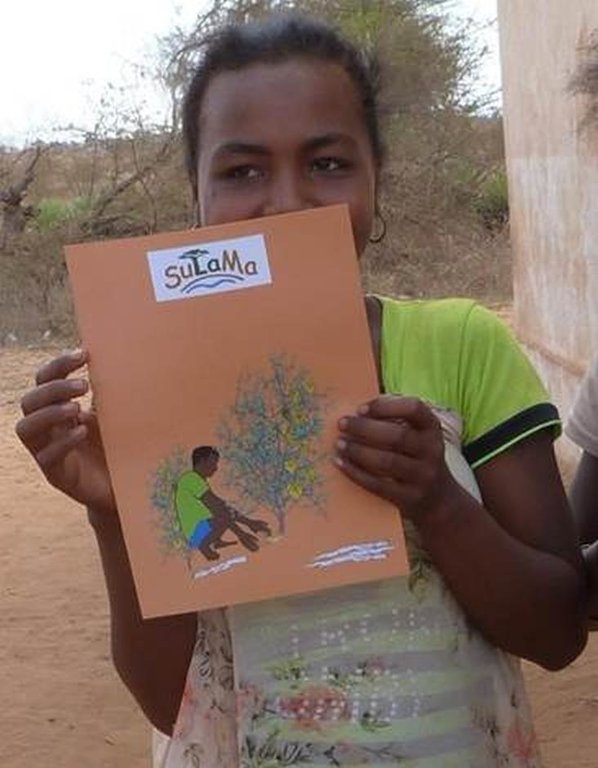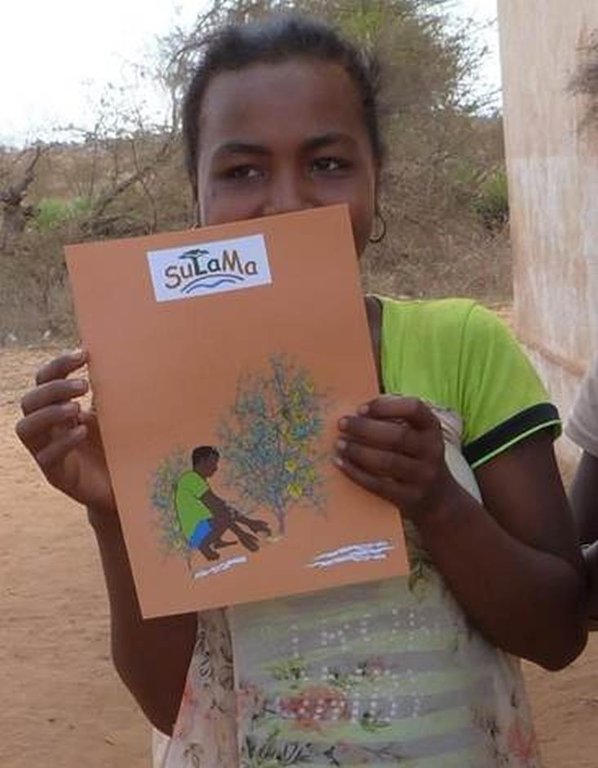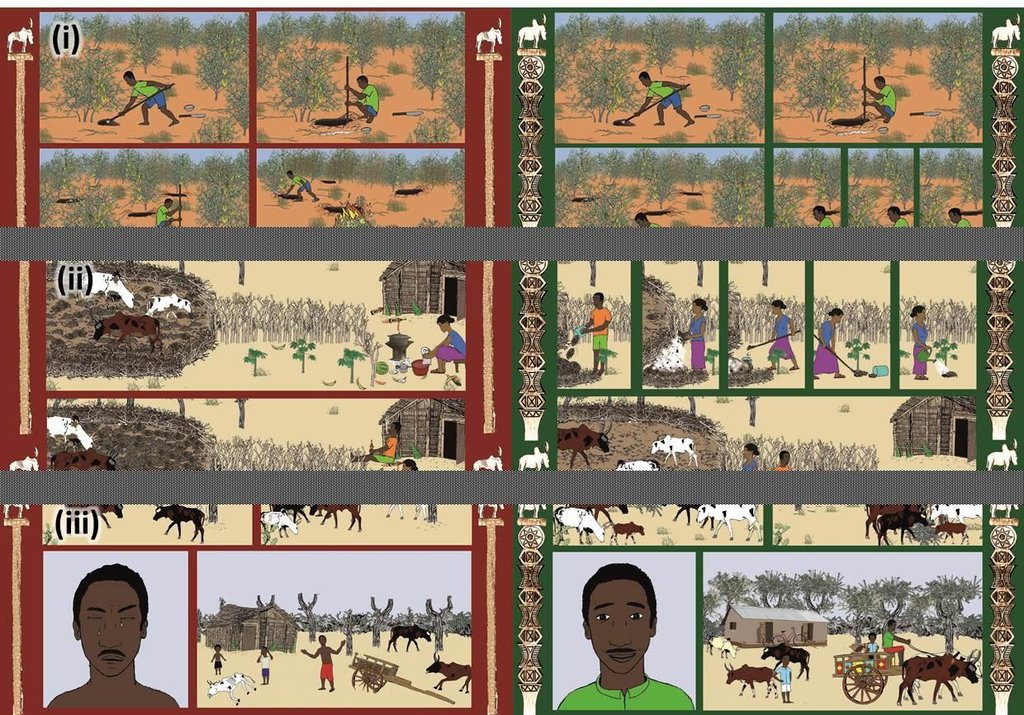Increasing environmental awareness using comic-style illustrations as a visual communication tool [Madagascar]
- Criação:
- Atualização:
- Compilador/a: Tobias Feldt
- Editor: –
- Revisor: Fabian Ottiger
approaches_2545 - Madagascar
Veja as seções
Expandir tudo Recolher tudo1. Informação geral
1.2 Detalhes do contato das pessoas capacitadas e instituições envolvidas na avaliação e documentação da abordagem
Especialista em GST:
Weiss David
mail@david-weiss.com
David Weiss Agrarcomics
Kirchstraße 18, D-37214 Witzenhausen http://david-weiss.com
Alemanha
Nome do projeto que facilitou a documentação/avaliação da Abordagem (se relevante)
Sustainable Landmanagement in south-western Madagascar (SuLaMa / GLUES)Nome da(s) instituição(ões) que facilitou(ram) a documentação/avaliação da Abordagem (se relevante)
Universität Kassel - Alemanha1.3 Condições em relação ao uso da informação documentada através de WOCAT
Quando os dados foram compilados (no campo)?
01/10/2015
O/a compilador/a e a(s) pessoa(s) capacitada(s) aceitam as condições relativas ao uso de dados documentados através da WOCAT:
Sim
1.4 Referência ao(s) questionário(s) sobre tecnologias da GST
2. Descrição da abordagem de GST
2.1 Descrição curta da abordagem
Communicating and transferring scientific results and recommendations about sustainable land management to local people
2.2 Descrição detalhada da abordagem
Descrição detalhada da abordagem:
Aims / objectives: The central aim of this approach was to increase environmental awareness in the Mahafaly region of southwestern Madagascar using visual communications tools. Comic-style illustrations were originally designed to communicate scientific recommendations on sustainable land management (SLM) and to ensure knowledge transfer from scientists to local people.
Methods: Visual communication, based on pictures, drawings, movies, sequential images and posters plays a vital role in countries where many people are illiterate. Another advantage is its easy reproduction in comparison to oral communication. It may also transfer knowledge where oral communication fails because of linguistic barriers or simply because complex narratives and messages are easier to explain visually than orally. In the context of a participatory research project to support SLM on the Mahafaly Plateau in southwestern Madagascar, comic-style illustrations of visual narratives were used to focus on environmental problems and SLM strategies. Since cross-cultural differences arise in “visual languages” globally, the visualization style needs to be carefully selected. Furthermore, misunderstanding of visual narratives may occur when objects are drawn not realistically enough, or if the statement is abstract or only presented from a scientific The central aim point of view. To avoid misinterpretation and increase readability and local acceptance, the style of comics was specifically designed for the conditions in rural Madagascar using a traditional Malagasy art style (sepulchre art in the form of “Aloalo” tomb sculptures). Comic illustrations were prepared to show the impact of different land use practices on the environment and local livelihoods using two contrasting stories/scenarios. The “red story” depicts a worst case scenario of unsustainable practices that are often applied by local inhabitants and the “green story” shows an example of a best case scenario based on an alternative, sustainable land management option recommended by scientific experts. To keep the stories simple and understandable, there was a focus on scientific key messages which can be easily transformed into visual narratives - and technical details were left aside.
Stages of implementation: The six year (2011-2016) transdisciplinary research consortium of Malagasy and German universities was initiated in the Mahafaly region of southwestern Madagascar in order to support sustainable land management (SuLaMa = Sustainable Land Management in southwestern Madagascar). Based on scientific research regarding the diversity and local use of forest resources and SLM practices in animal and crop husbandry, key messages and recommendations, which were easy to implement, were formulated by the scientific experts. Two examples of overused natural resources and one example of a neglected soil improvement practice were chosen for comic-style illustrations and transformed to visual narratives. These are (i) sustainable harvesting practice of wild yams (Dioscorea bemandry); (ii) composting of manure and its application to improve soil fertility and yields in home gardens; and (iii) sustainable utilization of the succulent tree Euphorbia stenoclada (called 'samata' in the local dialect) as supplementary forage for livestock. During an inception phase for the implementation of visual narratives in the study region, different drawing styles were tested and assessed to gather information on the local perception of art. Drawing styles showing the highest acceptance rate and readability were subsequently used to prepare the comics. The comics were printed on robust clay coated paper and handed out to local inhabitants during larger village workshops, where the different stories were presented and discussed.
2.3 Fotos da abordagem
2.5 País/região/locais onde a abordagem foi aplicada
País:
Madagascar
Região/Estado/Província:
Atsimo-Andrefana (South-West Madagascar)
Especificação adicional de localização:
Toliara II
2.6 Datas de início e término da abordagem
Indique o ano de início:
2015
Ano de término (caso a abordagem não seja mais aplicada):
2016
2.7 Tipo de abordagem
- Baseado em projeto/programa
2.8 Principais metas/objetivos da abordagem
The Approach focused mainly on SLM with other activities (sustainable land use, livestock husbandry, crop production, yams)
Comic-style illustrations were designed for environmental education purposes to communicate scientific results and recommendations on sustainable land management and ensure knowledge transfer from scientific experts to local people. It is the general aim of the approach to raise awareness for sustainable land use and environmental protection and therefore to improve both people's livelihoods and the efficiency in the use of natural resources.
The SLM Approach addressed the following problems: The approach area is characterized by low agricultural production, a lack of technical knowledge, low education level and conflicts over resource use.
2.9 Condição que propiciam ou inibem a implementação de tecnologia/tecnologias aplicada(s) segundo a abordagem
Normas e valores sociais/culturais/religiosos
- Inibitivo
People in the project area have a cultural reservation towards the utilization of animal dung, thus renouncing one of the fundamental principles for soil amelioration. At the same time, the declination of handling the animals' feces and therefore hardly ever cleaning their night enclosures strogly increases the risk of epizootic diseases and parasite infections.
Treatment through the SLM Approach: The comic drawings attempt to demonstrate how simple measures may have a sustainable impact in improving people’s livelihoods in many ways. They will at best be food-for-thought to reconsider culture-based practices that are not good SLM practice.
Quadro jurídico (posse de terra, direitos de uso da terra e da água)
- Inibitivo
With regard to the sustainable utilization of fodder trees, land ownership conflicts may arise as most of these trees around settlements stand on private ground – but without clear demarcation.
Treatment through the SLM Approach: Where currently there only exist single cactus plants or other hardly recognisable natural markings between plots, clear boundary lines between those plots could be illustrated as a good alternative in the respective comic.
The existing land ownership, land use rights / water rights hindered a little the approach implementation Some contents presented in the comic drawings, such as on the sustainable utilization of fodder trees, can conflict with land ownerships as most of these trees around settlements stand on private ground. Boundary lines between these plots, often only consisting of single cactus plants or other natural markings, may not be recognizable for outsiders but have to be included into the comics to avoid missunderstandings.
Carga de trabalho, disponibilidade de força de trabalho
- Inibitivo
Local people often do not see a direct benefit from higher workload e.g. by a more careful harvesting of forest products, the cleaning of livestock enclosures, or the utilization of manure for soil amelioration.
Treatment through the SLM Approach: The approach aims to show plainly the positive and sustainable impact of the alternative practices and the effect on people’s livelihoods.
Outro
- Inibitivo
The concept of some natural resources being finite is not very widespread among the local population.
Treatment through the SLM Approach: The approach may help local people to become more aware of this problem and to induce the
establishment of more sustainable land use practices.
3. Participação e papel das partes interessadas envolvidas
3.1 Partes interessadas envolvidas na abordagem e seus papéis
- Usuários de terra/comunidades locais
Crop and livestock farmers
Livestock related topics were addressed to male farmers as they are mainly involved in livestock husbandry.
- Organização não governamental
- Governo local
municipality, village
- Governo nacional (planejadores, responsáveis pelas decisões)
- Organização internacional
3.2 Envolvimento do usuários de terra/comunidades locais nas diferentes fases da abordagem
| Envolvimento do usuários de terra/comunidades locais | Especifique quem estava envolvido e descreva as atividades | |
|---|---|---|
| Iniciação/motivação | Nenhum | |
| Planejamento | Participativo | data surveys, questionnaires, group discussions |
| Implementação | Apoio externo | village workshops to present the comics and to explain the storylines. |
| Monitoramento/avaliação | Participativo | stepwise evaluation and improvement of comic understanding and acceptance by land users and the community |
| Research | Passivo |
3.3 Fluxograma (se disponível)
Descrição:
Extracts of three storylines on (i) yams harvesting, (ii) manure composting and (iii) the utilization of ‘samata’ (Euphorbia stenoclada)
Autor:
D. Weiss
3.4 Decisão sobre a seleção de tecnologia/tecnologias de GST
Especifique quem decidiu sobre a seleção de tecnologia/tecnologias a serem implementadas:
- Principalmente especialistas em GST, após consulta com usuários da terra
Explique:
During the six-year term of the original project, researchers gained a deep inside into the daily routine and workflow of the local population. The technology approach was therefore based on this knowledge and aimed at some of the major problems identified.
Decisions on the method of implementing the SLM Technology were made by mainly by SLM specialists with consultation of land users
4. Suporte técnico, reforço das capacidades e gestão do conhecimento
4.1 Reforço das capacidades/ formação
Foi oferecida formação aos usuários da terra/outras partes interessadas?
Sim
Especifique quem foi capacitado:
- Usuários de terra
- Equipe de campo/consultores
Tipo de formação:
- Áreas de demonstração
- Reuniões públicas
4.2 Serviço de consultoria
Os usuários de terra têm acesso a um serviço de consultoria?
Sim
4.3 Fortalecimento da instituição (desenvolvimento organizacional)
As instituições foram fortalecidas ou estabelecidas através da abordagem?
- Sim, moderadamente
Especifique a que nível (níveis) as instituições foram fortalecidas ou estabelecidas:
- Local
Especifique o tipo de apoio:
- Financeiro
- Reforço das capacidades/ formação
- Equipamento
Dê mais detalhes:
Local schools can be equipped with material and practical training courses can be developed with the collaboration of teachers, village chiefs and elders.
4.4 Monitoramento e avaliação
Monitoramento e avaliação são partes da abordagem?
Sim
Comentários:
technical aspects were regular monitored by project staff through observations; indicators: Data on land use practices were collected.
technical aspects were regular monitored by project staff through measurements; indicators: Data on human well-being and social conventions (customs, traditions, rituals) were collected.
socio-cultural aspects were regular monitored by project staff, land users through observations; indicators: Comics were distributed to land users and discussed with representatives of 15 villages.
no. of land users involved aspects were ad hoc monitored by None through observations
Evaluation aspects were ad hoc monitored by project staff through observations; indicators: evaluation of understanding and acceptance of comics
There were several changes in the Approach as a result of monitoring and evaluation: The understanding of the comics, their acceptance and the possible implementation of the land use approaches still have to be investigated during a follow-up evaluation process. There were few changes in the technologies. This still needs to be investigated during the evaluation process.
There were few changes in the Technology as a result of monitoring and evaluation: This still needs to be investigated during the evaluation process.
4.5 Pesquisa
A pesquisa foi parte da abordagem?
Sim
Especifique os tópicos:
- Sociologia
- Economia/Marketing
- Ecologia
- Tecnologia
Dê mais detalhes e indique quem realizou a pesquisa:
Research was carried out on-farm
5. Financiamento e apoio material externo
5.1 Orçamento anual para o componente de GST da abordagem
Caso o orçamento exato seja desconhecido, indique a faixa:
- 2.000-10.000
Comentários (p. ex. principais fontes de recursos/principais doadores):
Approach costs were met by the following donors: government (German Federal Ministry of Education and Research (BMBF)): 100.0%
5.2 Apoio financeiro/material concedido aos usuários da terra
Os usuários da terra receberam apoio financeiro/material para a implementação de tecnologia/tecnologias?
Sim
5.3 Subsídios para entradas específicas (incluindo mão-de-obra)
- Equipamento
| Especifique quais entradas foram subsidiadas | Em que medida | Especifique os subsídios |
|---|---|---|
| drawing material (pens and paper) | Totalmente financiado | |
Se a mão-de-obra pelos usuários da terra foi uma entrada substancial, isso foi:
- Voluntário
Comentários:
Travel expenses for the field trip of the comic illustrator was covered by the project
5.4 Crédito
Foi concedido crédito segundo a abordagem para atividades de GST?
Não
6. Análise de impactos e declarações finais
6.1 Impactos da abordagem
This still needs to be investigated during the evaluation process.
This still needs to be investigated during the evaluation process.
A abordagem melhorou as questões de posse de terra/diretos do usuário que inibiam a implementação das tecnologias de GST?
- Não
- Sim, pouco
- Sim, moderadamente
- Sim, significativamente
This still needs to be investigated during the evaluation process.
6.2 Principal motivação dos usuários da terra para implementar a GST
- Produção aumentada
- Lucro (lucrabilidade) aumentado, melhora da relação custo-benefício
- Prestígio, pressão social/coesão social
- Consciência ambiental
- well-being and livelihoods improvement
6.3 Atividades de sustentabilidade de abordagem
Os usuários da terra podem manter o que foi implementado através da abordagem (sem apoio externo)?
- Sim
Caso afirmativo, descreva como:
Land users can implement the technologies presented in the comics without further help. However for additional applications, new case-specific comic drawings will have to be prepared as the land users may not be able to transmit messages about other practices.
6.4 Pontos fortes/vantagens da abordagem
| Pontos fortes/vantagens/oportunidades na visão do usuário da terra |
|---|
| Structured surveys carried out after the distribution of the material showed that local people understood and generally accepted the comic stories. |
| Pontos fortes/vantagens/oportunidades na visão do/a compilador/a ou de outra pessoa capacitada |
|---|
| This approach has great potential for communication of any knowledge not only scientific. It should be further supported and widely used especially in rural areas with low literacy but not only there. Pictures have a great impact on peoples’ perception and messages can be easier memorized. |
| The more the pictures correspond with reality, the better is the “readability” and identification. The fewer the needless details shown, the better the recognition. |
| The environmental education material offers various possibilities of application, e.g. in schools or during village meetings. It can be used by the local communities over a long period of time. |
| As soon as an appropriate illustration style is found, various topics can be supplemented and more complex subjects can be depicted in greater detail. Individual comic strips may form the base for a more comprehensive but well understandable and adoptable compendium. |
6.5 Pontos fracos, desvantagens da tecnologia e formas de superá-los
| Pontos fracos/vantagens/riscos na visão do/a compilador/a ou de outra pessoa capacitada | Como eles podem ser superados? |
|---|---|
| Considerable investment and preparation is needed to implement comic-style illustration methods. Comic strips have to be provided in sufficient volume and quality, as reprinting is too expensive for local communities. | |
| In-depth knowledge and understanding of local traditions and practices is mandatory as apparently minor (incorrect) details and finesses may hamper the comprehensibility and acceptance of the comic strips. | |
| The design of comics that are both comprehensive and convertible by their contents for the local population requires a lot of time consuming preliminary work. If available, local artists and organizations should be called in and involved into this process to make sure, at the same time, that the approach can be carried on and developed by local stakeholders. |
7. Referências e links
7.1 Métodos/fontes de informação
- visitas de campo, pesquisas de campo
- entrevistas com usuários de terras
7.2 Referências às publicações disponíveis
Título, autor, ano, ISBN:
Andriamparany, J.N., 2015. Diversity, local uses and availability of medicinal plants and wild yams in the Mahafaly region of southwestern Madagascar.Andriamparany J.N., Brinkmann K., Whiele M., Jeannoda V., Buerkert A. (2015). Modelling the distribution of wild yam species in southwestern Madagascar using biotic and abiotic factorsFeldt, T., 2015. Interrelatedness of grazing livestock with vegetation parameters and farmers' livelihoods in the Mahafaly region, southwestern MadagascarFeldt, T., Schlecht, E., (2016). Analysis of GPS trajectories to assess spatio-temporal differences in grazing patterns and land use preferences of domestic livestock in southwestern MadagascarGoetter, J.F., Neudert, R., (accepted). New rules are not rules: privatization of pastoral commons and local attempts at curtailment in southwest MadagascarHanisch, S., 2015. Improving cropping systems of semi-arid southwestern Madagascar under multiple ecological and socio-economic constraintsWeiss, D. (2014). Visual communication: a promising approach in developing countries?
Disponível de onde? Custos?
PhD thesis, University of Kassel, Germany
Título, autor, ano, ISBN:
Andriamparany J.N., Brinkmann K., Whiele M., Jeannoda V., Buerkert A. (2015). Modelling the distribution of wild yam species in southwestern Madagascar using biotic and abiotic factors
Disponível de onde? Custos?
Agriculture, Ecosystems and Environment 212, p. 38-48.
Título, autor, ano, ISBN:
Feldt, T., 2015. Interrelatedness of grazing livestock with vegetation parameters and farmers' livelihoods in the Mahafaly region, southwestern Madagascar
Disponível de onde? Custos?
PhD thesis, University of Kassel, Germany
Título, autor, ano, ISBN:
Feldt, T., Schlecht, E., (2016). Analysis of GPS trajectories to assess spatio-temporal differences in grazing patterns and land use preferences of domestic livestock in southwestern Madagascar
Disponível de onde? Custos?
Pastoralism: Research, Policy and Practice 6 (1).
Título, autor, ano, ISBN:
Goetter, J.F., Neudert, R., (accepted). New rules are not rules: privatization of pastoral commons and local attempts at curtailment in southwest Madagascar
Disponível de onde? Custos?
International Journal of the Commons
Título, autor, ano, ISBN:
Hanisch, S., 2015. Improving cropping systems of semi-arid southwestern Madagascar under multiple ecological and socio-economic constraints
Disponível de onde? Custos?
PhD thesis, University of Kassel, Germany
Título, autor, ano, ISBN:
Weiss, D. (2014). Visual communication: a promising approach in developing countries?
Disponível de onde? Custos?
Bachelor thesis, University of Kassel, Germany
Links e módulos
Expandir tudo Recolher tudoLinks
Não há links
Módulos
Não há módulos






